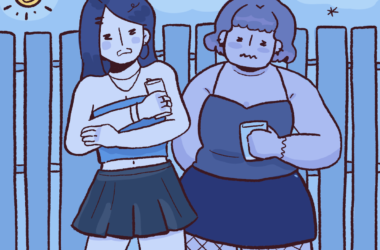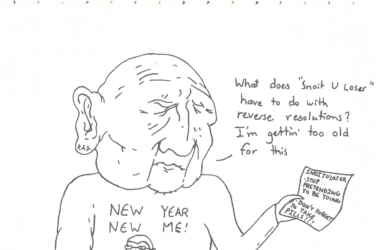I have always been fascinated by personal style, and I often wonder how our unique and individual styles are formed, what causes trends to come and go, and why we dress the way we do. Though we might assume that we can tell a lot about a person based on what they are wearing, in reality, we are only getting a small glimpse into their overall identity.
There is something refreshing and exhilarating about observing the street style in a diverse city like Montreal. For many, the city is a fresh start, a blank canvas for personal reinvention, and there is never any shortage of style inspiration walking down a crowded block in any one of Montreal’s neighbourhoods. From the quintessential Mile End toques and mushroom haircuts to sophisticated downtown workwear, Montrealers consistently express their histories, culture, opinions, and ideas through what they wear.
One possible influence on the development of individual style is the way people were raised and what they wore growing up. The clothes that people were exposed to as children have the potential to affect style choices in the present because they happen to be more available in their minds. Since sartorial tastes can come from subconscious places, it makes sense that our parents and other people we grew up around have the ability to affect our style choices just as they affect our mannerisms, behaviour, and personality. Additionally, people tend to gravitate towards the clothes that remind them of safety and that are associated with fond memories.
A staple of my own wardrobe is a brown suede jacket that I snagged a few years ago from my mother’s closet, much to her frustration. Not only is that jacket a vintage find that I’m sure would be difficult to get a duplicate of today, it also has deep sentimental value. My family used to take annual day trips every fall to a nearby orchard. As a kid, one of the highlights of those trips was the giant slides sitting atop makeshift hay stacks. I have a vivid mental image of my mom wearing that jacket as she slid down the giant slide, grinning from ear to ear with my younger brother in her arms. I might be inclined to purchase a similar jacket if I spotted it in a store today, but the sentimental value attached to the original makes me love hers even more.
Personal style at McGill tends to be highly creative and representative of our generation’s desire to experiment by trying out new trends and styles. Many undergraduates are still figuring out who they are and who they want to be, so for many, university is the opportunity to come into an identity, explore new things, and draw inspiration from peers.
Laura Cohendet, U3 Management, is a co-executive director for McGill’s Fashion Business Uncovered. Cohendet describes her own personal style as minimalistic with staple and long-lasting pieces.
“I like to invest in some quality, basic pieces and repurpose from there,” Cohendet said. “I got a pair of Levi’s jeans from Portobello Market in London, which is where a lot of designers go to seek inspiration and where individual merchants set up shops. You can find a lot of quality pieces there, and my jeans are vintage, so I paid more for them than I would for a pair of fast fashion jeans, but I wear them all the time.”
Cohendet noted that there are people with similar styles worldwide, which creates a sense of community in the fashion industry.
“Everyone has their own individualistic style and curates the image [that] they want to portray to the world every day when they wake up,” Cohendet said. “[…] I think that, within the world, even though you might feel like you’re dressing uniquely, there are other individuals maybe in Brazil or Paris that have similar styles, and that creates tribes that dress similarly [….] I think that everyone belongs to one of these tribes.”
Rachael Atkinson, U3 Management, finds it difficult to pin down her style, but is a big fan of thrifting a range of pieces and using them in different ways.
“My style is hard to define, and its influences are far and wide,” Atkinson said. “[…] But I like to thrift a lot, which gives me a lot of really interesting pieces and has developed my style so that it exists at both ends of the spectrum, from the classic Coco Chanel and Jackie O to the more eccentric and modern Comme des Garçons. I don’t necessarily have one go-to. I draw from […] everything.”
Advertising and mainstream fashion also strongly influence style. The more people see and are exposed to trendy pieces, the more likely they are to react positively to them without necessarily knowing why. If many people see a bizarre new style in a store window, only those with an interest in fashion or a real sense of adventure are likely to buy it immediately. But once everyone has seen it on a few people, scrolled through multiple ads for it, and started to recognize it as something normal, the piece can begin to move from the subconscious to the conscious mind, and the mainstream might end up giving it a try.
Trends also make it easier to fit in with our peers, as we see certain groups of people who identity with different ‘looks.’ Our brains are constantly picking up clues and signals from everyone around us, so it is likely that our styles sometimes resemble those of the people we are with the most.
A study in the online magazine Perception led by assistant cognitive science professor Mark Changizi of Rensselaer Polytechnic Institute showed how direct and repeated exposure to ads increases consumer preference for promoted products, and explained why the most effective ads are often those that consumers do not even realize.
“The frequency with which an individual is visually exposed to an object can provide evidence of this expected gain, and our brains have developed mechanisms that exploit this information, rationally modulating our preferences,” Changizi said to ScienceDaily.
Our culture constantly bombards us with pressure to buy, accumulate, and always seek bigger and better. When it comes to clothes, no matter how full our closets are, many of us complain that we have nothing to wear. Consumers in the Western world generally believe that they are totally free to express themselves and dress how they please. At the same time, however, many try to conform to images from mainstream advertising and media as an approximation of their ideal image. There are norms and expectations imposed on us every day, and the clothes we wear vary according to our goals, jobs, and overall social position.
Ultimately, style is the ability to sort through an abundance of options, make a distinct choice, and do so in a way that conforms to how we see ourselves and how we want to be seen. Style is a stamp of personal identity and a visible image to the world. It is an ode to creativity and novelty as well as an excursion into self-expression and our personalities. It is a reflection of our unique complexities as human beings, a self-knowledge and self-confidence expressed through what we choose to wear, and a life-affirming symbol of character and spirit.







